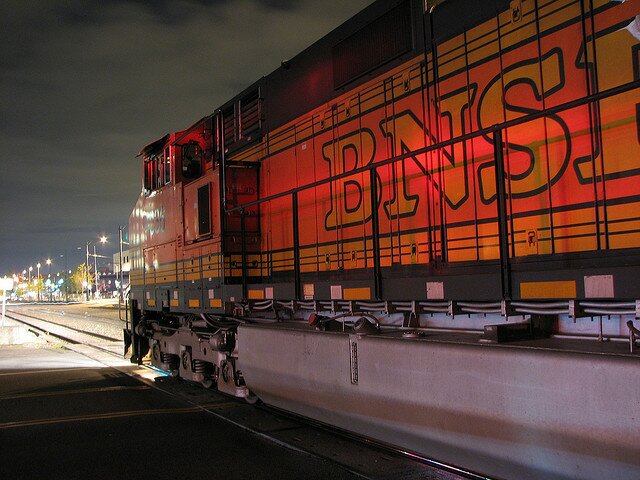
Of your four major coal groups, Powder River Basin coal falls into the “sub-bituminous” variety, low in sulfur comparatively, but lower in energy content, averaging 8,500 btu per pound (anthracite can produce upwards of 15,000 btu per pound). You’ll find the Powder River Basin in southeast Montana and northeast Wyoming, where it contributes to Wyoming’s status as the leading coal-producing state in the country.
Regulating sulfur emissions from coal plants, to reduce acid rain, was the best thing to happen to coal mining companies in the West; it made low-sulfur, low-energy coal economically viable. However, it’s like switching to low-tar cigarettes–there’s more than just sulfur to be concerned about.
It may seem odd for Washington State to be caught up in the debate over the future of Powder River Basin coal: About 73 percent of the state’s electricity is produced by hydroelectricity, with coal providing just eight percent. But that eight percent of coal-powered electricity produces 74 percent of greenhouse gas emissions tied to electricity generation.
Recognizing this, state environmentalists and other people who like to breathe clean air have been pushing for the closure of Centralia’s TransAlta plant, in tandem with a national trend toward regulating coal-fired plants, as they currently exist, out of business. This is perturbing to coal companies, as the U.S. possesses huge resources of coal, hundreds of years’ worth, and yet their domestic market is declining. (Despite, nationally, just over 50 percent electricity being coal-generated–retiring these plants marks a huge shift in fuel dependency.)
But, as tobacco companies learned before them (as a side-note, tobacco company-style PR strategy was employed in the fight against sulfur regulation, so this isn’t a drive-by association), foreign markets are not so regulated. So it is possible to cede regulation to the U.S. while increasing sales overseas. The possibility of undercutting competitors on price in selling to China’s coal buyers depends, though, on there being Western ports capable of handling the volume and weight of coal shipments.
There would be so much coal traveling–the coal companies have argued publicly for one amount, while planning for a larger one–that a host of side-effects may arise where you wouldn’t expect. Coal dust pollution, which can cause emphysema, bronchitis, and black lung, could be a longer-term problem with around a terminal shipping tens of millions of metric tons of coal per year. How much would come back, airborne, as mercury and smog? And then there’s the sheer physical presence of, say, nine 1.5-mile-long trains per day traveling at in-city speeds.
Not surprisingly, some in the communities of Longview and Bellingham are drawn to the prospect of jobs creation, with a full-time terminal workforce of a few hundred. Sightline researcher Eric de Place says he understands the need for jobs, but that the coal-terminal boosters are ultimately “short-sighted.” “The toughest thing is the jobs question,” he admits, not because there are that many, or because the economic impact is so great, but simply because so many people are out of work in Whatcom and Cowlitz counties.
De Place argues that a state with a governor who has already made “some strong statements” about the need to phase out coal-burning plants (and who is, I note, familiar with tobacco company-style strategies) has already established a baseline for what’s both moral and responsible when it comes to coal-generated electricity. The atmosphere not being a great respecter of political borders, he notes, it makes little sense to suppress greenhouse gas emissions in one spot, and facilitate the generation of even more elsewhere.
One of de Place’s recent posts on Sightline surfaced a white paper on the economics of cheap coal:
One of the nation’s most respected resource economists, Dr. Thomas M. Power, just released a new white paper showing that coal exports to China will increase that country’s coal burning and pollution, and decrease investments in energy efficiency.
In a nutshell, Power demonstrates that the planned coal export facilities in the Northwest would add to the supply of coal to China thereby pushing down the cost of burning it. And because China is highly cost sensitive, even relatively small changes in price could result in significant changes in coal burning.
You wouldn’t think this required study, but PRB coal companies, as part of their “everyone else is doing it” argument, had suggested that their contribution would have no impact on China’s overall coal consumption, so it might as well be them as opposed to someone else. This was a little improbable on the face of it, as no one has suggested that China has satisfied its demand for energy.
If, in a perfect world, we could satisfy the need for jobs, it’s likely that far fewer, outside those directly employed by coal companies, would be arguing for these port projects, versus other trade opportunities. But, that being the case, doesn’t it make sense to work towards the perfect world, rather than in the opposite direction? What we would seem to learn from the debate is that the heartland of the U.S. is just a train-ride away from shipping to China.